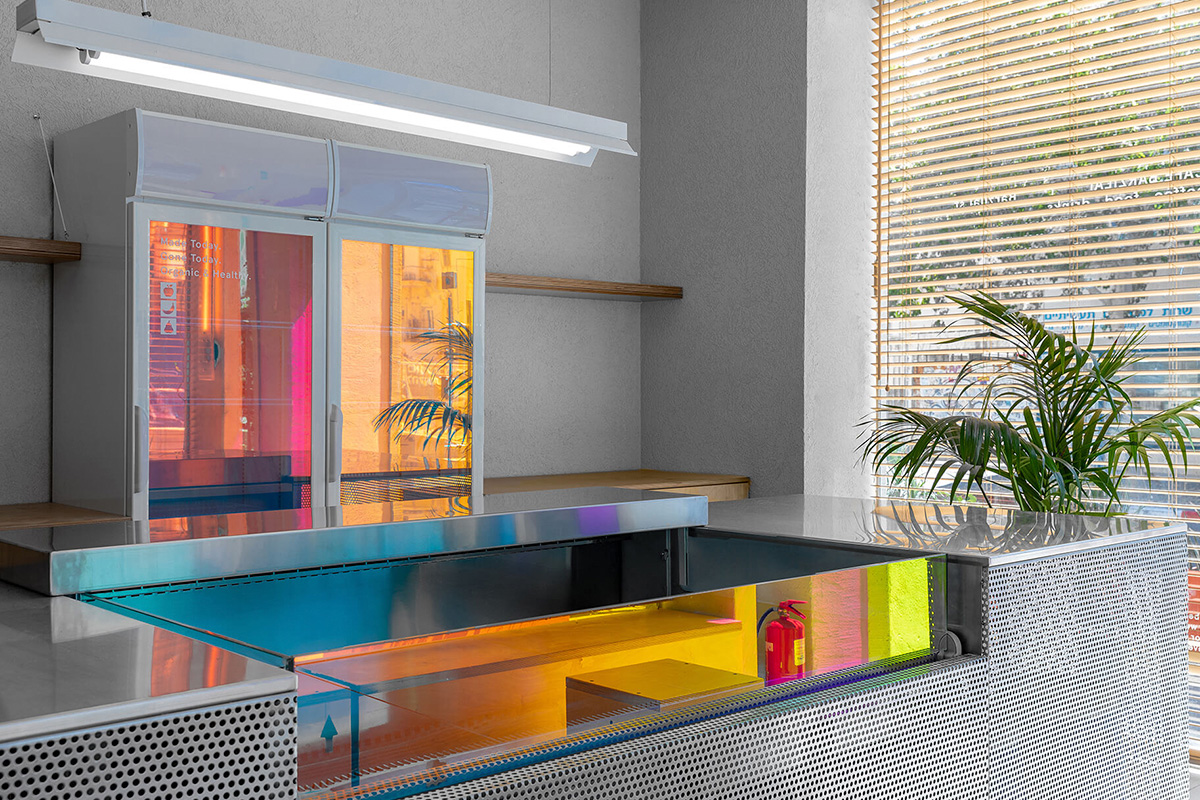«In the end the Metaverse will be a layer on top of reality», says Simon Barazin, architect based in Tel Aviv engaged in the exploration of the latest opportunities offered to users by the Metaverse
Lampoon presents Simon Barazin Studio
Located in Tel Aviv, Studio Simon Barazin (SSB) is a design platform devoted to the development of both traditional and digital projects. Combining the two souls of its founder and owner – Simon Barazin – the studio engages in a wide range of architectural projects, from cafes and residential spaces, to Metaverse and immersive environments. Architect by training, Barazin studied in Jerusalem and worked for an architectural firm focused on residential buildings and other traditional architectural projects.
«In my free time, I was involved in interior design activities for friends and small clients in Tel Aviv, like cafes, restaurants. My passion always lies in design and in the small scale, I would call it the ‘human scale’. When you design big buildings you deal mainly with the economic and engineering aspects of architecture», Barazin explains. Back in his early twenties, Barazin used to express his creativity in an interdisciplinary way through graffiti, street art and painting.
Growing up he soon realized that in the mainstream industrial architectural field he would not have been able to do so. Hence the desire to open his own studio and focus on interior design. The outbreak of Covid-19 was for Barazin both a catastrophe and a driving force: he suddenly found himself unemployed without any support from the Israeli government, but the crisis also provided him with the right amount of time and motivation to put his own business project in place.
Building communities
In 2022 Barazin’s latest architectural project saw the light: 20 beans, a new concept coffee shop located in Tel Aviv local market. Conceived in collaboration with Madrid-based studio Tapa Space and Bate Agency during the first lockdown, its aesthetics draws inspiration from the market’s structure, characterized by raw materials, loose edges and unfinished designs.
«We worked together virtually during the first lockdown. Architecture is very local, physical, but we collaborated mainly on a conceptual level through the internet», Barazin claims. Technology and social media contributed to the development of Barazin’s studio and portfolio, having become a powerful tool for the enjoyment of many aspects of our life, including design and architecture.
«Internet and social media influenced my work as people now experience architecture also through their phones. In architecture school we studied many buildings that we never saw in person, we just had small glimpses or fragments of these spaces through computer screens», he explains.
Enhancing cooperation between creatives through technology
Social media also played a key role in building a strong virtual community, allowing him to connect with design enthusiasts and other creatives from all over the globe; Ukraine, Brazil and Russia. What Barazin finds fascinating about the possibility to engage with people through the internet is that, despite the distance and the different cultural backgrounds, the new generations of architects and artists share numerous cultural influences.
Video games, pop culture, comics, cartoons – all of which impact their aesthetic and production practices. «When planning a space I do not only design the floor, the ceiling and all the traditional architectural features, but I conceive the experience as a whole». This process takes place mainly during the rendering phase thanks to his digital graphic skills.
His ability to combine the materiality of architecture with the digital world enables the production of design projects where the border line between real and virtual seems blurred: «When people photograph my works with their sharp edges and bright colors they get a feeling of oddness, you never know if the images are real or virtual».
The new frontiers of the Metaverse in the architectural practice
Barazin’s passion for video games combined with his pioneering attitude – enhanced by the pandemic, led him to explore the latest frontier of immersive technologies: the Metaverse. In 2021 he curated a virtual art exhibition featuring his business partner’s ‘phygital’ objects, BL1NDs. Ronen Tanchum is a contemporary artist, developer and an interaction designer specialized in the production of NFTs.
Barazin’s main interests however lie in the new possibilities of connection between people, offered by the internet from an evolutionary perspective from web 2.0 to web 3.0. «I am amazed by this environment where people can interact and connect. Most of these spaces are not reachable yet as many people still think that the Metaverse is still connected only to Apes, cryptocurrencies and economic dynamics. But what I found is that these platforms are often led by enthusiasts or CG artists. As a visual architect I am interested in creating spaces of possibilities for unplanned interactions and experiences».
In collaboration with his partner Barzin has developed Space A – Gallery of NFT Art and Virtual Architecture. The space, divided into three main areas – two rotating galleries and a central space used for discourse and meeting , is a gateway aimed at connecting the virtual and physical world through ‘phygital’ events, such as parties and art exhibitions, while completing the gallery activities which take place in real life.
Metaverse: a space for human connections
As an architect, Barazin is familiar with limitations as the physical world imposes barriers to human creation, such as gravity, air, scale, materials. On the other hand digital spaces’ limitations involve hardware, file types and sizes. «Architects always work within contexts, but the Metaverse is revolutionary in this sense. It opens new frontiers of scale and fruition through phone screens, VR viewers and so on», he explains.
Experts, researchers and tech companies are trying to figure out the next evolutions of this groundbreaking technology and artists such as Barazin are not far behind. In the future, he assumes, the Metaverse revolution – just like the social media revolution occurred in the first decade of the twenty-first century – will give rise to another level of communication between people.
Digital spaces will not take over the real world, but will provide users with new ways to experience the material world thanks to disruptive technological tools in the form of augmented reality. «In virtual space I see myself more as a content creator than an architect. In the end the Metaverse will be a layer on top of reality».
New ways to experience the material world thanks to disruptive technological tools
In the last few months Barazin has been working on an ambitious Metaverse project together with a Ukrainian studio which, before the war, was designing a new music and dance club. The first outline of the project consisted of a virtual reproduction of the original club, but after a thorough discussion they decided to expand the project involving several aspects of the life of Ukrainian people, now scattered all over Europe.
«We want to reunite, in this virtual space, all the dispersed culture of young Ukranians and refugees who had to leave their devastated country . They lost so many things, but they still have a lot to say. I met a few refugees here in Israel who are creative but do not have the opportunity to express their artistry due to cultural and language gaps or social and economic struggles».
In order to facilitate social encounters between fellow-citizens, they planned a digital space made of different virtual rooms, each with a specific purpose. The meditation room, for instance, will be a safe place for sharing experiences and testimonies, meeting psychologists and easing traumas, but also a way to deliver war crime evidence to the world through creative means, such as video and documentaries.
Web 3.0 and the Metaverse immersive artistic experiences
This project includes physical events alongside the virtual initiatives creatives will put in place in the Metaverse. «We have so many fundraising projects here in Tel-Aviv, they could be a starting point for creating in person events which could be spread all over the world through technology». Creative freedom for all users is also a key point of the project.
Architects and designers will only be involved in the designing and planning phases, being the physical space and materiality the least key aspects. With physical architecture and cities you can get lost and have unplanned encounters. In the virtual world it has always been the opposite as the internet and web 2.0 feed us what we already like, it is all based on algorithms».
According to Barazin, web 3.0 and the Metaverse have the power to go beyond these dynamics by providing immersive artistic experiences to all users. Despite acknowledging that the road is still long and they are only in an explorational phase, Barazin and his fellow Ukrainian colleagues have a proactive attitude.
Simon Barazin
Born in Ukraine and based in Tel Aviv, Simon Barazin formerly worked as a residential-focused architect and urban planner before launching SB Studio in 2017. Barazin exists as a catalyst for collaborations with designers, graphic and virtual artists (Tal Baltuk, Tom Melnick) from around all over the world. Digital aesthetics is a central motif in the studio’s work – the daily use of computerized technologies from 3D design to VR simulations leave a visual mark on the studio’s projects alongside influences from the worlds of web, gaming, digital art, and social networks.




















